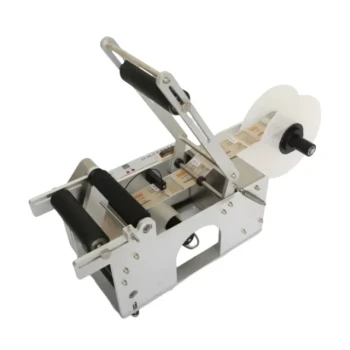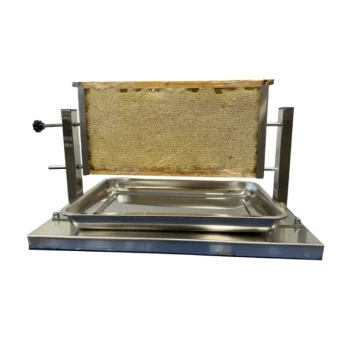For optimal honey press efficiency, your comb should be warmed to a temperature range between 80°F (27°C) and 104°F (40°C). The lower end of this range ensures the honey flows freely, while the upper limit is critical for preserving the honey's natural enzymes and delicate qualities. Exceeding this temperature will degrade your final product.
The core challenge in pressing honey is managing viscosity. You must warm the comb just enough to make the honey flow easily for efficient extraction, without applying so much heat that you damage its nutritional value and flavor.
Why Temperature is a Critical Factor
The temperature of your honeycomb directly impacts both the quantity of honey you can extract and the quality of that honey. Understanding the physics involved is key to mastering the process.
The Problem with Cold Comb
Cold honey is highly viscous, meaning it is thick and resists flowing. Pressing cold or even room-temperature comb is inefficient.
The press will struggle to separate the thick honey from the wax, resulting in a significantly lower yield. Much of your valuable honey will remain trapped in the discarded wax cappings.
The Benefit of Gentle Warming
Warming the comb to at least 80°F (27°C) is the minimum threshold to achieve good results.
This gentle heat lowers the honey's viscosity, allowing it to flow easily under pressure. The wax also becomes softer and more pliable, making the entire pressing process smoother and more effective.
The Upper Limit: Protecting Honey Quality
While warmth is beneficial, excessive heat is the primary enemy of high-quality, raw honey. There is a clear point of diminishing returns where more heat harms your product more than it helps your yield.
How Heat Damages Honey
Honey contains beneficial enzymes and delicate aromatic compounds that give it its unique flavor and health properties.
Heating honey above 104°F (40°C) begins to destroy these sensitive substances. As temperatures climb higher, this degradation happens rapidly, fundamentally altering the honey's character from a raw, natural product to a simple sweetener.
Understanding the Trade-offs
Every decision in honey processing involves a balance. Your ideal temperature depends on what you prioritize.
Efficiency vs. Quality
Pushing the temperature toward the upper end of the safe range (95-104°F or 35-40°C) may extract a marginally higher percentage of honey.
However, this comes at the increased risk of creating hot spots and beginning to degrade the honey's quality. Sticking to the lower end (80-85°F or 27-29°C) is a safer bet for preserving the raw characteristics of the honey.
Gentle Methods vs. Direct Heat
The safest way to warm your comb is to let it sit in a heated room until it reaches the desired ambient temperature. This process is slow but ensures even, gentle warming.
Using dedicated warming cabinets or tools is faster but requires careful monitoring to avoid overheating sections of the comb.
Making the Right Choice for Your Goal
Use your primary objective to guide your temperature setting within the recommended safe range.
- If your primary focus is preserving maximum raw honey quality: Aim for the lower end of the range, ensuring the comb is just warm to the touch, around 80-85°F (27-29°C).
- If your primary focus is maximizing yield and speed: You can work at the higher end, from 95°F up to a strict maximum of 104°F (35-40°C), but monitor your process carefully to prevent overheating.
Ultimately, managing temperature is about finding the sweet spot that respects both the honey and your goals.
Summary Table:
| Goal | Recommended Temperature Range | Key Benefit |
|---|---|---|
| Maximize Raw Quality | 80°F - 85°F (27°C - 29°C) | Preserves delicate enzymes & flavor |
| Balance Yield & Speed | 95°F - 104°F (35°C - 40°C) | Efficient extraction with careful monitoring |
| Absolute Maximum | Do not exceed 104°F (40°C) | Prevents degradation of honey's properties |
Achieve the perfect press every time with professional-grade equipment from HONESTBEE.
For commercial apiaries and distributors, precise temperature control is non-negotiable for producing high-yield, premium-quality honey. HONESTBEE supplies durable, reliable beekeeping supplies and equipment designed for wholesale-focused operations, helping you standardize your process and protect your product's integrity.
Contact our experts today to discuss wholesale solutions for your honey pressing needs.
Related Products
- Professional Thermostatic Conical Honey Melter
- Honey Concentrating Vacuum Heating Thickening Machine Dehumidifier for Honey
- 8-Frame Electric Self-Reversing Honey Extractor Spinner for Commercial Honey Extraction Equipment
- 0.5T Capacity Honey Dehumidifier Dryer with Vacuum Heating and Thickening Filtering Machine
- High Quality Honey Dehumidifier Dryer Thickening Machine for Beekeeping
People Also Ask
- Does honey get thinner when heated? How to Safely Restore Its Liquid State
- What does heating up honey do? Uncover the Impact on Flavor and Nutrition
- What temperature spoils honey? Protect Your Honey's Quality with Proper Temperature Control
- What equipment is commonly used for heating and processing honey? Essential Tools for Every Beekeeper
- What is melter honey used for? A Low-Cost Ingredient for Bakers and Brewers



















